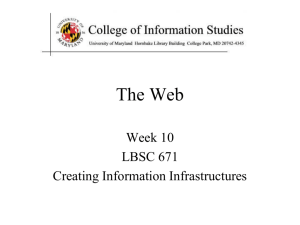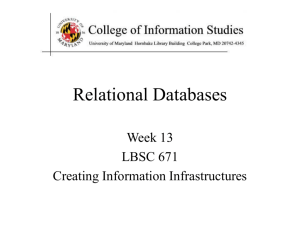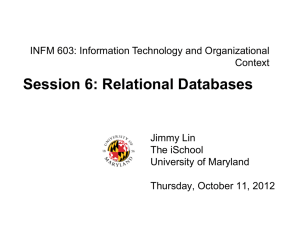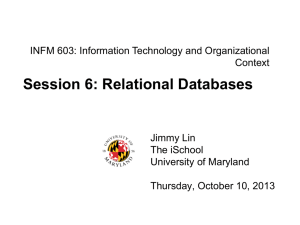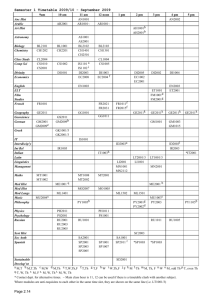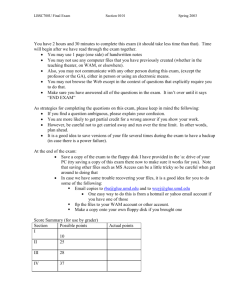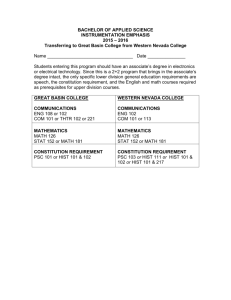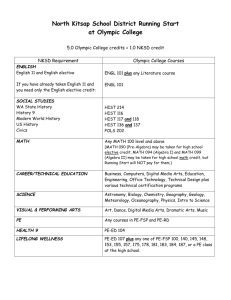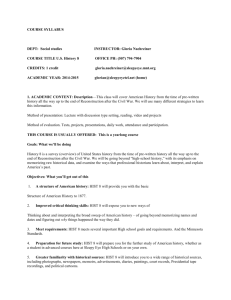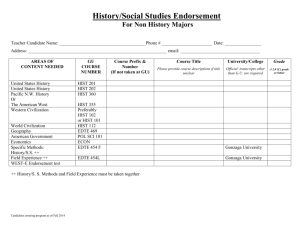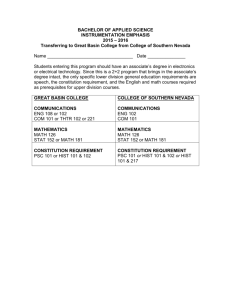Network and Internet
advertisement
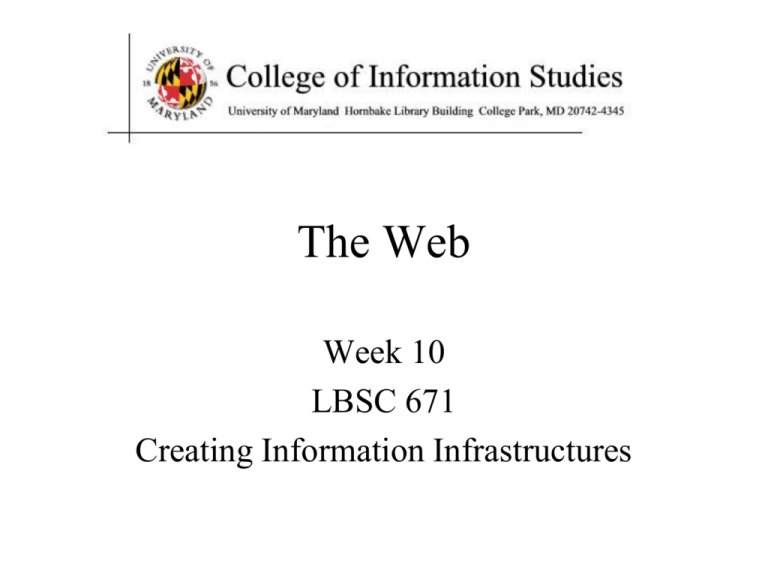
The Web Week 10 LBSC 671 Creating Information Infrastructures Virtual Private Networks a secure private network over the public Internet Public Internet Intranet virtual “leased line” Intranet Tonight • Think about what the Web “is” • Learn to create a Web page • Begin to think about Web design • Talk conceptually about databases Internet Web • Internet: collection of global networks • Web: way of managing information exchange • There are many other uses for the Internet – File transfer (FTP) – Email (SMTP, POP, IMAP) The World-Wide Web My Browser Local copy of Page requested Requested Page Proxy Server Fetch Page Send Request Internet Remote Sever “The Web” HTML HTTP URL Email FTP RTSP Web URL Server (e.g.,http://www.foo.org/snarf.html) File System HTML (data/display) Internet communication protocols HTTP (transfer) What is the Web? • Protocols – HTTP, HTML, or URL? • Perspective – Content or behavior? • Content – Static, dynamic or streaming? • Access – Public, protected, or internal? Perspectives on the Web • Web “sites” – In 2002, OCLC counted any server at port 80 – Total was 3 million, an undercount • Misses many servers at other ports • Some servers host unrelated content (e.g., TerpConnect) • Web “pages” – In 2012, Google counted any URL it has seen – Total was 30 trillion, an overcount • Includes dead links, spam, … • Web “use” – Google users pose 3 billion queries a day Crawling the Web Robots Exclusion Protocol • Requires voluntary compliance by crawlers • Exclusion by site – Create a robots.txt file at the server’s top level – Indicate which directories not to crawl • Exclusion by document (in HTML head) – Not implemented by all crawlers <meta name="robots“ content="noindex,nofollow"> Web Crawl Challenges • Discovering “islands” and “peninsulas” • Duplicate and near-duplicate content – 30-40% of total content • Link rot – Changes at ~1% per week • Network instability – Temporary server interruptions – Server and network loads • Dynamic content generation Duplicate Detection • Structural – Identical directory structure (e.g., mirrors, aliases) • Syntactic – Identical bytes – Identical markup (HTML, XML, …) • Semantic – Identical content – Similar content (e.g., with a different banner ad) – Related content (e.g., translated) Link Structure of the Web Nature 405, 113 (11 May 2000) | doi:10.1038/35012155 Global Internet Users 4% 2% 4% 4% 5% 0% 4% 2% 5% 33% 8% English Chinese 5% Spanish 2% Japanese 6% Portuguese German 6% Arabic 4% French 64% 5% Russian Korean 9% 28% ne se rd u li an 800 G er m 900 es e di /U Ja pa n Hi n Be ng a Ar ab ic Fr en ch Po rtu gu es e En gl ish Sp an is h Ru ss ia n Ch i Number of Speakers (millions) Most Widely-Spoken Languages 1000 Secondary Primary 700 600 500 400 300 200 100 0 Source: Ethnologue (SIL), 1999 Global Trade Source: World Trade Organization 2010 Annual Report Why is there a Web? • Affordable storage – 300,000 words/$ in 1995 • Adequate backbone capacity – 25,000 simultaneous transfers in 1995 • Adequate “last mile” bandwidth – 1 second/screen in 1995 • Display capability – 10% of US population in 1995 • Effective search capabilities – Lycos and Yahoo were started in 1995 Web Standards • HTML – How to write and interpret the information • URL – Where to find it • HTTP – How to get it Uniform Resource Locator (URL) • Uniquely identify Web pages Domain name File name http://www.glue.umd.edu:80/~oard/teaching.html Protocol Port Path HyperText Markup Language (HTML) • Simple document structure language for Web • Advantages – Adapts easily to different display capabilities – Widely available display software (browsers) • Disadvantages – Does not directly control layout “Hello World” HTML This is the header <html> <head> <title>Hello World!</title> </head> <body> <p>Hello world! This is my first webpage!</p> </body> </html> This is the actual content of the HTML document Hands On: Learning HTML From Examples • Use Internet Explorer to find a page you like – http://www.glue.umd.edu/~oard • On the “Page” menu select “View Source” (in IE) – Opens a notepad window with the source • Compare HTML source with the Web page – Observe how each effect is achieved Hands On: “Adopt” a Web Page • Modify the HTML source using notepad – For example, change the page to yours • Save the HTML source somewhere – In the “File” menu, select “Save As” – Put the name in quotes (e.g., “test.html”) • FTP it to your ../pub directory on terpconnect • View it – http://terpconnect.umd.edu/~(yourlogin)/test.html Tips • Edit files on your own machine – Upload when you’re happy • Save early, save often! • Reload browser to see changes • File naming – Don’t use spaces – Punctuation matters HTML Document Structure • “Tags” mark structure – <html>a document</html> – <ol>an ordered list</ol> – <i>something in italics</i> • Tag name in angle brackets <> – Not case sensitive (unlike XML) • Open/Close pairs – Close tag is sometimes optional (unlike XML) Logical Structure Tags • Head – Title • Body – – – – – – Headers: <h1> <h2> <h3> <h4> <h5> Lists: <ol>, <ul> (can be nested) Paragraphs:<p> Definitions: <dt><dd> Tables: <table> <tr> <td> </td> </tr> </table> Role: <cite>, <address>, <strong>, … Physical Structure Tags • • • • • Bold: <b></b> Italics: <i></i> Typeface: <font face=“Arial”></font> Size: <font size=“+1”></font> Color: <font color=“990000”></font> (Hyper)Links index.html <html> <head> <title>Hello World!</title> </head> <body> <p>Hello world! This is my first webpage!</p> <p>Click <a href="test.html">here</a> for another page.</p> </body> </html> test.html <html> <head> <title>Another page</title> </head> <body> <p>This is another page.</p> </body> </html> Hypertext “Anchors” • Internal anchors: somewhere on the same page – <a href=“#students”> Students</a> • Links to: <a name=“students”>Student Information</a> • External anchors: to another page – <a href=“http://www.clis.umd.edu”>CLIS</a> – <a href=“http://www.clis.umd.edu#students”>CLIS students</a> • URL may be complete, or relative to current page – <a href=“video/week2.rm”>2</a> • File name (in URL) is case sensitive (on Unix servers) – Protocol and domain name are not case sensitive Images • <img src=“URL”> or <img src=“path/file”> – – – – – <img src=“http://www.clis.umd.edu/IMAGES/head.gif”> SRC: can be url or path/file ALT: a text string ALIGN: position of the image WIDTH and HEIGHT: size of the image • Can use as anchor: – <a href=URL><img src=URL2></a> • Example: – http://www.umiacs.umd.edu/~daqingd/Image-Alignment.html Tables <table> <tr> <td> eenie </td> <td> <tr> <td> mo </td> <td> <tr> <td> by </td> <td> </table> </td><td> mennie miney </td> </tr> catch </td><td> a tiger</td> the </td><td> toe </tr> </td> </tr> Table Example <table align=“center”> <caption align=“right”>The caption</caption> < tr align=“LEFT”> <th> Header1 </th> <th> Header2</th> </tr> <tr><td>first row, first item </td> <td>first row, second item</td></tr> < tr><td>second row, first item</td> <td>second row, second item</td></tr> </table> Wire Framing • Design, brainstorming technique – – – – Highly conceptual Low-fi Low risk, low cost Rapid • Incorporates three elements of Web design: – Information design: Which information will go where? – Navigation design: How will users get around? – Interface design: How do elements convey functionality? Databases • Database – Collection of data, organized to support access – Models some aspects of reality • DataBase Management System (DBMS) – Software to create and access databases • Relational Algebra – Special-purpose programming language Structured Information • Field An “atomic” unit of data – number, string, true/false, … • Record A collection of related fields • Table A collection of related records – Each record is one row in the table – Each field is one column in the table • Primary Key The field that identifies a record – Values of a primary key must be unique • Database A collection of tables A Simple Example primary key Registrar Example • Which students are in which courses? • What do we need to know about the students? – first name, last name, email, department • What do we need to know about the courses? – course ID, description, enrolled students, grades A “Flat File” Solution Student ID Last Name 1 Arrows 1 Arrows 2 Peters 2 Peters 3 Smith 4 Smith First Name John John Kathy Kathy Chris John Department IDDepartmentCourse ID Course description Grades email EE EE lbsc690 Information Technology 90 jarrows@wam EE Elec Engin ee750 Communication 95 ja_2002@yahoo HIST HIST lbsc690 Informatino Technology 95 kpeters2@wam HIST history hist405 American History 80 kpeters2@wma HIST history hist405 American History 90 smith2002@glue CLIS Info Sci lbsc690 Information Technology 98 js03@wam Discussion Topic Why is this a bad approach? Goals of “Normalization” • Save space – Save each fact only once • More rapid updates – Every fact only needs to be updated once • More rapid search – Finding something once is good enough • Avoid inconsistency – Changing data once changes it everywhere Relational Algebra • Tables represent “relations” – Course, course description – Name, email address, department • Named fields represent “attributes” • Each row in the table is called a “tuple” – The order of the rows is not important • Queries specify desired conditions – The DBMS then finds data that satisfies them A Normalized Relational Database Student Table Student ID 1 2 3 4 Last Name Arrows Peters Smith Smith First Name John Kathy Chris John Department ID EE HIST HIST CLIS Department Table Course Table Department ID EE HIST CLIS Course ID lbsc690 ee750 hist405 Department Electronic Engineering History Information Stuides email jarrows@wam kpeters2@wam smith2002@glue js03@wam Course Description Information Technology Communication American History Enrollment Table Student ID 1 1 2 2 3 4 Course ID lbsc690 ee750 lbsc690 hist405 hist405 lbsc690 Grades 90 95 95 80 90 98 Approaches to Normalization • For simple problems (like the homework) – Start with “binary relationships” • Pairs of fields that are related – Group together wherever possible – Add keys where necessary • For more complicated problems – Entity relationship modeling (LBSC 670) Example of Join Student Table Student ID Last Name 1 Arrows 2 Peters 3 Smith 4 Smith Department Table First Name John Kathy Chris John Department ID EE HIST HIST CLIS email jarrows@wam kpeters2@wam smith2002@glue js03@wam Department ID EE HIST CLIS Department Electronic Engineering History Information Stuides “Joined” Table Student ID Last Name 1 Arrows 2 Peters 3 Smith 4 Smith First Name John Kathy Chris John Department IDDepartment EE Electronic Engineering HIST History HIST History CLIS Information Stuides email jarrows@wam kpeters2@wam smith2002@glue js03@wam Problems with Join • Data modeling for join is complex – Useful to start with E-R modeling • Join are expensive to compute – Both in time and storage space • But it is joins that make databases relational – Projection and restriction also used in flat files Some Lingo • “Primary Key” uniquely identifies a record – e.g. student ID in the student table • “Compound” primary key – Synthesize a primary key with a combination of fields – e.g., Student ID + Course ID in the enrollment table • “Foreign Key” is primary key in the other table – Note: it need not be unique in this table Project New Table Student ID Last Name 1 Arrows 2 Peters 3 Smith 4 Smith First Name John Kathy Chris John Department IDDepartment EE Electronic Engineering HIST History HIST History CLIS Information Stuides email jarrows@wam kpeters2@wam smith2002@glue js03@wam SELECT Student ID, Department Student ID 1 2 3 4 Department Electronic Engineering History History Information Stuides Restrict New Table Student ID Last Name 1 Arrows 2 Peters 3 Smith 4 Smith First Name John Kathy Chris John Department IDDepartment EE Electronic Engineering HIST History HIST History CLIS Information Stuides email jarrows@wam kpeters2@wam smith2002@glue js03@wam WHERE Department ID = “HIST” Student ID Last Name 2 Peters 3 Smith First Name Department IDDepartment Kathy HIST History Chris HIST History email kpeters2@wam smith2002@glue Entity-Relationship Diagrams • Graphical visualization of the data model • Entities are captured in boxes • Relationships are captured using arrows Registrar ER Diagram Enrollment Student Course Grade … has Student Student ID First name Last name Department E-mail … associated with has Course Course ID Course Name … Department Department ID Department Name … Getting Started with E-R Modeling • What questions must you answer? • What data is needed to generate the answers? – Entities • Attributes of those entities – Relationships • Nature of those relationships • How will the user interact with the system? – Relating the question to the available data – Expressing the answer in a useful form “Project Team” E-R Example manage-role 1 student M member-of M implement-role human client 1 needs 1 team 1 creates 1 M project d php-project ajax-project Components of E-R Diagrams • Entities – Types • Subtypes (disjoint / overlapping) – Attributes • Mandatory / optional – Identifier • Relationships – Cardinality – Existence – Degree Types of Relationships Many-to-Many 1-to-Many 1-to-1 Making Tables from E-R Diagrams • Pick a primary key for each entity • Build the tables – One per entity – Plus one per M:M relationship – Choose terse but memorable table and field names • Check for parsimonious representation – Relational “normalization” – Redundant storage of computable values • Implement using a DBMS Normalization • 1NF: Single-valued indivisible (atomic) attributes – Split “Doug Oard” to two attributes as (“Doug”, “Oard”) – Model M:M implement-role relationship with a table • 2NF: Attributes depend on complete primary key – (id, impl-role, name)->(id, name)+(id, impl-role) • 3NF: Attributes depend directly on primary key – (id, addr, city, state, zip)->(id, addr, zip)+(zip, city, state) • 4NF: Divide independent M:M tables – (id, role, courses) -> (id, role) + (id, courses) • 5NF: Don’t enumerate derivable combinations Normalized Table Structure • • • • • • • Persons: id, fname, lname, userid, password Contacts: id, ctype, cstring Ctlabels: ctype, string Students: id, team, mrole Iroles: id, irole Rlabels: role, string Projects: team, client, pstring A More Complex ER Diagram cadastral: a public record, survey, or map of the value, extent, and ownership of land as a basis of taxation. Source: US Dept. Interior Bureau of Land Management, Federal Geographic Data Committee Cadastral Subcommittee http://www.fairview-industries.com/standardmodule/cad-erd.htm Key Ideas • Databases are a good choice when you have – Lots of data – A problem that contains inherent relationships • Design before you implement – This is just another type of programming – The mythical person-month applies! • Join is the most important concept – Project and restrict just remove undesired stuff Before You Go On a sheet of paper, answer the following (ungraded) question (no names, please): What was the muddiest point in today’s class?
